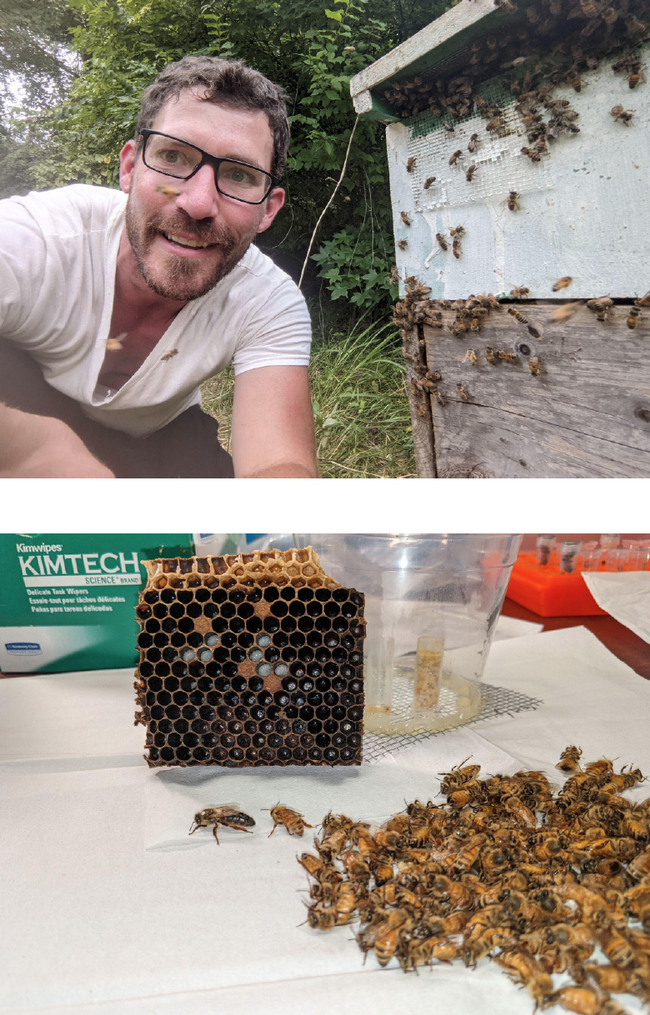
"I took a gap decade. During that time I had a series of eclectic jobs and life experiences. Those experiences proved extremely useful during my PhD."
Lamas, a former commercial beekeeper in New Hampshire, will share his life and research experiences at a seminar hosted by the UC Davis Department of Entomology and Nematology, on Monday, April 15.
His seminar, titled "How Doing a PhD Is Like Building a House," begins at 4:10 p.m. in Room 122 of Briggs Hall. It also will be on Zoom. The Zoom link:
https://ucdavis.zoom.us/j/9 5882849672
"This presentation describes how the intersection of life experiences and my PhD led to creative and generative research that led to large discovery in disease transmission dynamics in collapsing honey bee colonies," Lamas says.
A first-generation college student, Lamas received his bachelor's degree in biology in 2008 from Colby-Sawyer College, a private college in New London, New Hampshire. He obtained his doctorate in entomology at the University of Maryland in 2022.
He credits his mentor, USDA-ARS research entomologist Jay Evans of the Bee Research Laboratory, Beltsville, MD., with encouraging him to apply to become an Oak Ridge Institute for Science and Education (ORISE) fellow with the USDA-ARS Research Participation Program.
Lamas, known as "Dr. Zac," has presented programs on his research and beekeeping management to state beekeeping associations in California, Texas, Florida, Colorado, Virginia, Missouri, West Virginia, and Washington State, among others, and has addressed the American Beekeeping Federation, American Honey Producers' Association and Apimondia. Globally, he has delivered presentations to Apimondia, Montreal, Canada, and to the Eurbee 8th Congress of Apidology, Ghent, Belgium.
Lamas rears open-mated carniolans. "These are docile, productive bees, that I produce for my own experiments," he writes on his website. "We can literally pet our bees during experiments. This level of docility allows us to work intimately with the bees, sitting in front of open colonies for long periods to collect samples."
Lamas is a noted researcher on varroa mites. "Who do Varroa really feed on? Check out this presentation where I share a new finding of Varroa destructor I carried out three years of research, and along with collaborators (including my family!) individually inspected over 30,000 bees to describe the distribution of Varroa inside a colony." (See YouTube presentation.)
Lamas' recent publications involve varroa mites, infectious diseases and pesticides:
- Zachary S. Lamas, Eugene V. Ryabov, David J. Hawthorne, Jay D. Evans, "Oversharing by honey bees and the spread of viruses," bioRxiv 2022.05.15.492017; DOI: https://doi.org/10.1101/2022.05.15.492017
- Ryabov EV, Posada-Florez F, Rogers C, Lamas ZS, Evans JD, Chen Y and Cook SC (2022) "The vectoring competence of the mite Varroa destructor for deformed wing virus of honey bees is dynamic and affects survival of the mite," Frontiers in Insect Science. 2:931352. DOI: 10.3389/finsc.2022.931352
- Posada-Florez, F., Lamas, Z.S., Hawthorne, D.J. et al. "Pupal cannibalism by worker honey bees contributes to the spread of deformed wing virus," Scientific Reports 11, 8989 (2021). https://doi.org/10.1038/s41598-021-88649-y
- Alger, S.A.1, Burnham, P.A., Lamas, Z.S2, Brody, A.K., Richardson, L.R., (2017). "Home sick: impacts of migratory beekeeping on honey bee (Apis mellifera) pests, pathogens, and colony size," PeerJ 6:e5812; DOI 10.7717/peerj.5812
- Kirsten S. Traynor, Dennis vanEngelsdorp, Zachary S. Lamas, "Social disruption: Sublethal pesticides in pollen lead to Apis mellifera queen events and brood loss," Ecotoxicology and Environmental Safety, Volume 214, 2021, 112105, ISSN 0147-6513, https://doi.org/10.1016/j.ecoenv.2021.112105
Honey bee scientist Brian Johnson, associate professor, UC Davis Department of Entomology and Nematology, is coordinating the department's seminars for the 2023-24 academic year. For any Zoom technical issues, he may be reached at brnjohnson@ucdavis.edu.
The complete list of spring quarter seminars is here.
Attached Images:
